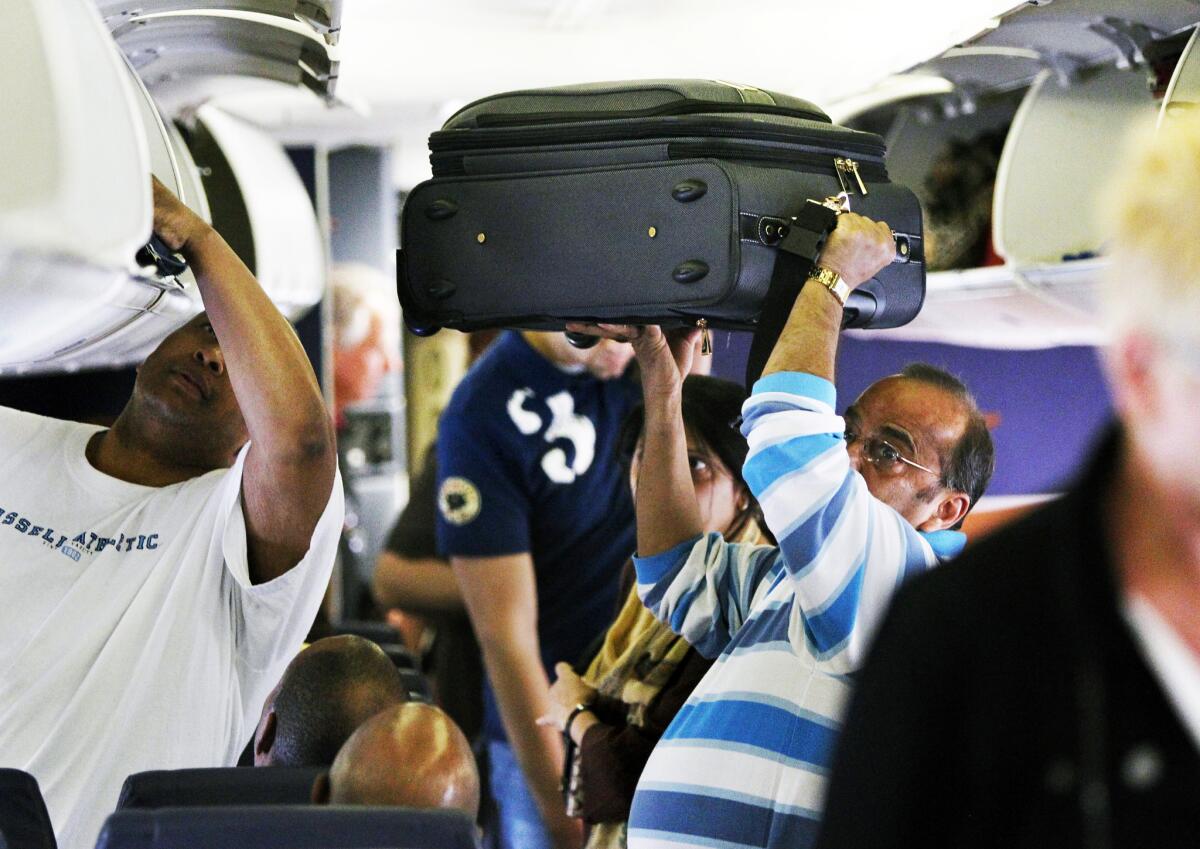First-class cabin fuels ‘air rage’ among passengers flying coach, study says

Inequality on airplanes can predict air rage incidents, a new study finds.
- Share via
If you’ve felt your blood pressure rise after seeing first-class passengers being served Champagne on the tarmac while you’re fighting for overhead space in coach, you are not alone.
A new study finds that class division in the skies can have a real and occasionally dangerous effect on passengers in both sections of a plane.
Researchers report that the simple presence of a first-class cabin on an airplane is correlated with an almost fourfold increase in the frequency of “air rage” incidents in economy class.
And when economy-class passengers are forced to pass through the luxurious first-class area on their way to the cramped economy seats, the rate of air rage incidents is more than seven times higher than if there are no first-class seats at all.
The study, published Monday in the Proceedings of the National Academy of Sciences is based on data collected by a large international airline over several years and many thousands of flights.
However, in order to get access to the data, the authors agreed not to reveal the name of the airline.
“These companies have a lot of fear about releasing this type of data to the public,” said lead study author Katherine DeCelles, an associate professor of organizational behavior at the University of Toronto. “People like to bash airlines whenever they can.”
To be clear, true air rage is actually quite rare. DeCelles said it might include an intoxicated passenger refusing to sit down, or a passenger who has just been told to turn her phone off making a verbal threat to an in-flight worker.
On average, these incidents occur in economy class just .14 times per 1,000 flights when there is no first-class cabin, but 1.58 times per 1,000 flights when there is a first-class cabin.
Among first-class passengers, air rage incidents occur 0.31 times per 1,000 flights.
-------------
For the record
9:55 a.m.: An earlier version of this post mischaracterized the frequency of “air rage” incidents in first class as 0.14 per 1,000 flights. There are .31 incidents in first class per 1,000 flights.
-------------
“The very definition of the air rage phenomenon is that it has to endanger the safety of the flight,” DeCelles said. “It has to be pretty extreme to warrant documentation.”
Join the conversation on Facebook >>
Still, with a large data set, certain patterns emerged. The authors found that the presence of a first-class cabin predicted the chances of air rage better than a number of other factors, including how much legroom there was on the plane, how wide the seats were, and even how long a plane had been delayed.
The authors report that the presence of first class was associated with greater odds of air rage similar to the effect of a nine-hour, 29-minute flight delay.
And when economy passengers boarded the plane from the front, rather than the middle, and had to see the first-class luxury they were missing, the chances of air rage was similar to the effect of a 15-hour flight delay.
However, DeCelles said there may be some factors that could have a greater effect on the odds of an air rage incident that were not included in the study.
“We don’t have a measure of how much alcohol people were drinking, that might have a bigger effect,” she said. “Also, we would assume that the hotter the flight is, the more aggressive people will be, but we did not have temperature data.”
Based on the findings, DeCelles has a few recommendations for airlines to minimize potential air rage incidents.
“I don’t think it is feasible to get rid of first class, and it’s not something the average customer expects,” she said. “But the average customer expects to be treated well.”
She suggests airlines refrain from rubbing the inequality between first class and coach in their economy passengers’ faces. For example, making people in coach wait in long lines for the bathroom when the first-class bathroom has no line is problematic. Also, closing the curtains between the two cabins could reduce feelings of anger, she said.
“One time I was in economy and they were baking chocolate chip cookies for the first-class passengers only,” DeCelles said. “The smell came back and that was hard. Just anything they can do operationally to reduce that type of feeling would be helpful.”
Do you love science? I do! Follow me @DeborahNetburn and “like” Los Angeles Times Science & Health on Facebook.
ALSO
To feel better, eat less (yes, even if you’re not overweight)
Boiling water may have carved mysterious streaks on Mars, study finds
Found: Three Earth-sized planets orbiting a dim, red sun. ‘This is only the beginning’




